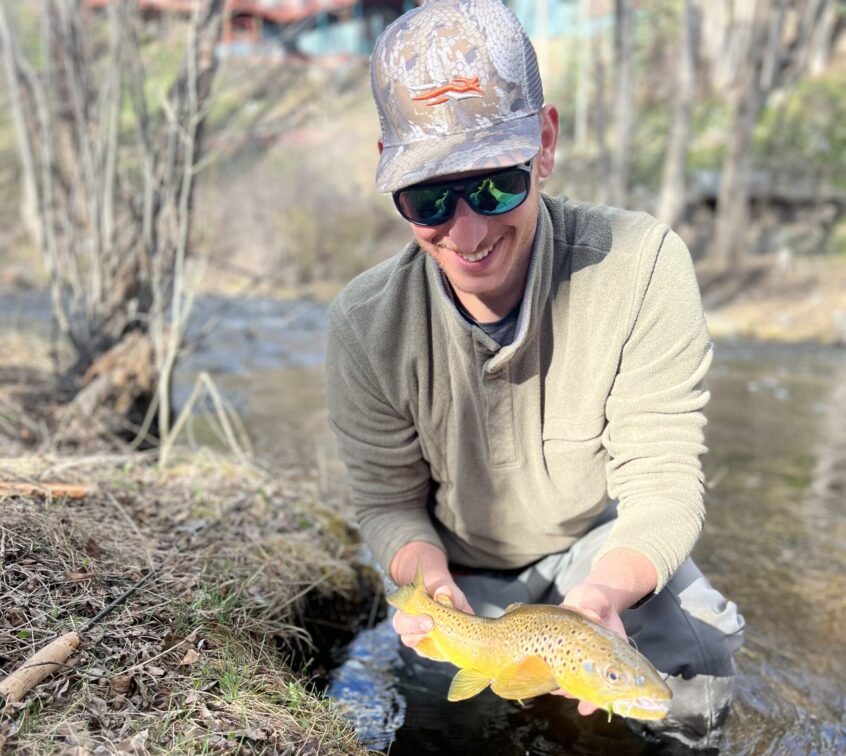Flows and Water Clarity
Water levels on the Roaring Fork have dropped with the recent cold weather. Flows are 389 cfs below Maroon Creek and 955 cfs at Emma. Water levels have risen significantly! Visibility is low.
Overview
With rain earlier this week, flows have risen quite a bit! Runoff is definitely happening and conditions can change quickly. On rainy days or following warm weather, expect increased flows and cloudy water. That means it’s time for the big nasty bugs! Stoneflies, worms, big jig style nymphs, flashy bugs and streamers are the name of the game. Caddis have started popping on the fork, if you haven’t tried fishing caddis nymphs yet, give it a try! If water clarity is decent where you’re fishing, downsize your flies and opt for more natural colors.
Reading water is an important skill this time of year. As flows jump, fish will be pushed closer to the bank, into eddies and behind rocks where they can stay out of strong current. Focus your efforts on these likely places, often when you find one fish you find many during this time of the year!
Don’t forget that streamers are on the menu this time of year– if you’ve been holding off on chucking meat, now might be a good time to give it a try. For more information on Spring Streamer Fishing, click here.
As runoff occurs, think about where tributaries that are likely to bring turbid water into the system are. Fishing higher up in the system usually means better water clarity and visibility– remember that conditions aren’t uniform throughout the entire valley!
As mentioned above, conditions will probably be variable this week. If you want more in depth information on a specific day this week, give us a call or drop by the shop to get the most recent conditions and information.
Changing conditions require you to adapt as an angler, making this a fun time of year to put your skills to the test! There is some great fishing to be had, but you need to know when and what to fish. As always, our guides are on the water every day and in tune with these changes. Booking a guide trip is a great opportunity to brush up on technique before the summer season starts and increase your chances of landing fish!
We continue to be on the lookout for spawning activity, if you see anything please, let us know as we want to make sure we’re helping local anglers stay off of redds. Decreased visibility means it can be hard to see where you’re stepping, so try to avoid wading through shallow tail outs as that’s where redds are most likely to be. Read more below.
PSA The Rainbow Trout Spawn
We know that for the most part the fly fishing community is educated and thoughtful about responsible use of the resource and protecting future generations of fish, but we think that it is still worth reminding everyone to be mindful of spawning fish as we move into spring.
Trout create spawning beds or “Redds,” which are generally found in shallow, moving water. Identifying these redds is an important skill as an angler and helps us fish ethically. Redds are generally composed of smaller rocks and gravel that are lighter in color than the rest of the river bottom due to spawning fish brushing the rocks as they mate and clearing them of algae and other organic material. These beds provide safety for the eggs and alveins (fry) that are a result of the spawn and the next generation of fish!
Stay away from redds, fish deeper water where trout are actively feeding, and use good fish handling practices. If you are hitting the water with someone who is new to the sport, please use this time of year as an opportunity to share how to fish ethically and be a steward of the resource. To learn more about fishing during the spring spawn, click here and share!
Common Hatches and Food Sources
Stoneflies, Worms, Caddis and BWOs
Though midges and BWO’s are still present (and will catch fish), we’re switching over to bigger flies like stones, worms and caddis with the increased flows and decreased visibility. Smaller stonefly patterns (size 14-18) that were productive earlier in the spring are still definitely working, but larger bugs (size 8-12) are working now too. If you can fish big, why wouldn’t you! We seeing caddis get active on the fork, fishing hare’s ears, frenchies, sparkle caddis, and UV caddis has been working well.
Hot flies & Techniques
Nymphs
Point Flies
Hot Flies: Pat’s Rubber Legs/Girdle Bug (size black, coffee, brown 6-14), 20 incher (size 8-14, natural), Prince Nymph (size 8-16), Squirmy or San Juan Worm (Tan, Pink, Blood Worm), Guide’s Choice Hare’s ear (size 12-16), Frenchie Style flies (12-16), Perdigon (pearl, size 16), Caddis Flash Rib Jig Fly (size 14-16).
Tungsten jigs with hot collars (yellow, brown, pink, size 12-16), Eggs (chartreuse, peach, white). Pheasant Tails (black, natural, flashback 12-16).
Hot Flies: Guide’s Choice Hare’s Ear (size 16-18), Two Bit Hooker (black, size 16), Sparkle Caddis (size 16), Flashback Pheasant Tail (size 14-16), Prince Nymph (size 16),
UV Caddis (size 14-16), Plan B Caddis (size 14-16), , Pheasant Tail (natural 18-20), Hot Mess caddis (size 14)
Midges and Baetis (best when water clarity is good)
Epoxy Midge (Red, size 16-18), WD40 (black, gray, size 16-18), RS2’s (cdc, crystal wing, black, gray, size 16-18), Juju Baetis (red, olive, black size 18-22)
Dries:
We’re still seeing the occasional BWO hatch, but caddis are starting to make their way up the fork! If you see fish rising, you can try a double dry set up with a caddis in the front, trailed by a size 16-18 BWO pattern.
Hot Flies: Elk Hair Caddis (black body, olive size 14-16), Caddis Variant Ginger (size 14-16),
Element Hi-Vis Midge (black, size 20) Parachute Adams (18-20), BWO Hackle Stacker (18-20)
Streamers:
Bring a streamer rod with you this time of year! It never hurts to target some structure and see what happens! It’s been a little streaky, but we love fishing streamers whenever we can!
Hot Flies: Thin Mint (size 8-10), Trick Or Treat (size 6), Mini Dungeons (black, white, natural (size 8)
Mini D&D (purple, olive size 6), Motor Oil (black, size 6), Slumpbuster (natural, size 8-12), Thin Mint (size 6-10).
Techniques
Nymphing is the most productive technique during this time of year. Finding deep holding water and using weight to get your flies down will be crucial to success. Longer leaders and heavy split shot will help you get your flies in front of more fish. Leading with larger jig style or tungsten patterns has been a very productive technique for helping smaller flies get down deeper.
Decreased visibility during runoff provides us the opportunity to fish larger, flashier flies and use heavier tippet. Adjust size, flash and tippet selection depending on the water clarity where you’re fishing. As water levels continue to rise, fish will get pushed into pockets and eddies closer to the bank, but if whitewater isn’t ripping through your favorite holes yet, there are still fish hanging out there,
Dry fly hatches are beginning to increase in frequency, so keep an eye out for pods of rising fish. Spring dry fly hatches can be sporadic compared to the summer months, but are incredibly fun and rewarding to fish. Midges, BWO’s and Caddis are all common spring hatches.
Streamers are also an important tool in your toolbox during the spring! Small streamers with a slower retrieve tend to be best when water temps are low and the water is clear. As water temps increase and clarity gets off color, try the big nasty flashy stuff! It’s a ton of fun. Focus your efforts on deep pools and structure and cover a lot of water for the best results.
Information About The Roaring Fork
The Roaring Fork River is a freestone river that runs 70 miles from Independence Pass through Aspen, Basalt, and Carbondale until it reaches its confluence with the Colorado River in Glenwood Springs. The cold, clean waters of this famous river support an incredible array of aquatic life including brown, rainbow and cutthroat trout. The Roaring Fork is designated as a “Gold Medal” fishery, meaning it offers some of the best trout fishing in the nation to beginners and seasoned anglers alike.

